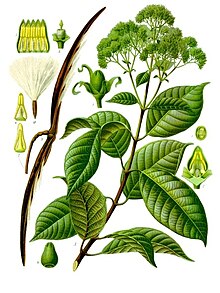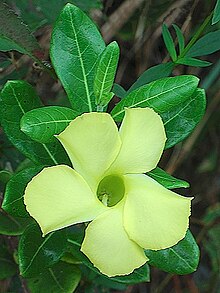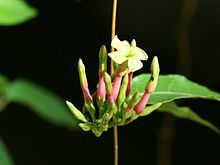Apocynoideae
| Apocynoideae | ||||||||||||
|---|---|---|---|---|---|---|---|---|---|---|---|---|

|
||||||||||||
| Systematics | ||||||||||||
|
||||||||||||
| Scientific name | ||||||||||||
| Apocynoideae | ||||||||||||
| Burnett |
The Apocynoideae are a subfamily in the plant family of the dog poison plants (Apocynaceae). In this subfamily there are some species whose varieties are used as ornamental plants .
description


Appearance and leaves
The subfamily Apocynoideae includes some trees , shrubs and herbaceous plants , but especially lianas and succulents . Many species contain a (mostly clear) milky sap . The majority of the species are evergreen . The opposite or alternate leaves are usually simple and have entire margins. Stipules are present or absent.
Inflorescences, flowers and fruits
Mostly panicle inflorescences are formed.
The hermaphroditic, radially symmetrical flowers are four or five-fold with a double perianth . The four or five sepals are green to colored. The usually five petals are fused tubular or funnel-shaped. There is only one circle with five free or intergrown, fertile stamens . The stamens are often fused or adherent to the carpels. There is often a discus . The mostly two carpels are mostly to upper constant (syncarp) ovary grown or they are rare apokarp; so free.
There are berries , stone , bellows or capsule fruits formed. The seeds are often hairy and / or have a tuft of hair.
Systematics













The subfamily of the Apocynoideae was established in 1835 by Gilbert Thomas Burnett .
The Apocynoideae subfamily contains about 80 genera.
The subfamily of the Apocynoideae was described by Endress et al. 2007 in eight tribes and since Endress et al. 2014 divided into nine tribes:
- Tribe Apocyneae
Rchb. :
-
Aganonerion Pierre ex Spire : It contains only one species:
- Aganonerion polymorphum Spire : It occurs in Indochina .
- Aganosma (flower) G.Don : The approximately nine species occur from southern China to western Malesia .
-
Amalocalyx Pierre : it contains only one species:
- Amalocalyx microlobus Pierre ex Spire : It occurs from southern Yunnan to Indochina.
-
Amphineurion (A.DC.) Pichon : It contains only one species:
- Amphineurion marginatum (Roxb.) DJMiddleton : It occurs from tropical Asia to China.
- Anodendron A.DC. : The approximately 17 species are distributed from tropical to subtropical Asia.
- Apocynum L .: The fouror sospecies are distributed from southern Europe to China and North America.
-
Baharuia D.J.Middleton : it contains only one type:
- Baharuia gracilis D.J.Middleton : It comes in the northwestern Sumatra and Borneo ago.
- Beaumontia Wall. : With nine species that occur from tropical Asia to southern China.
- Chonemorpha G.Don : The ten or so species occur in tropical Asia and China.
- Cleghornia Wight : There are about two species from Sri Lanka to western Malesia and China.
-
Dewevrella De Wild. : It contains only one type:
- Dewevrella cochliostema De Wild. : It occurs in the Republic of the Congo , the Democratic Republic of the Congo and Gabon .
- Epigynum Wight : The five or so species are distributed from tropical Asia to southern China.
- Ichnocarpus R.Br. : The three or so species are distributed from tropical Asia to southern China and northern Australia.
-
Ixodonerium Pit. : It contains only one type:
- Ixodonerium annamense Pit. : It only occurs in central Vietnam .
- Micrechites Miq. : The twelveor sospecies are distributed from the eastern Himalayas to the Solomon Islands .
-
Papuechites Markgr. : It contains only one type:
- Papuechites aambe (Warb.) Markgr. : It occurs from the Moluccas to the Bismarck Archipelago .
- Parameria Benth. : The three or so species are distributed from Malesia to southern China.
-
Parepigynum Tsiang & PTLi : It contains only one species:
- Parepigynum funingense Tsiang & PTLi : It occurs in northern Vietnam and in the Chinese provinces of Guizhou and southern Yunnan .
- Pottsia Hook. & Arn. : The threeor sospecies occur on Java and from northeast India to southern China.
-
Sindechites olive. : It contains only one type:
- Sindechites henryi oliv. : It occurs in southern China.
- Star jasmine ( Trachelospermum Lem. ): The nine or so species are distributed from tropical to subtropical Asia.
- Urceola Roxb. : The approximately 17 species are distributed from tropical to subtropical Asia.
- Vallaris Burm. f. : The three or so species are distributed from tropical Asia to southern China.
-
Aganonerion Pierre ex Spire : It contains only one species:
- Tribus Baisseeae (Pichon ex de Kruif) MEEndress (Syn .: Baisseinae Pichon ex De Kruif ): She received the rank of Tribus in 2007. The three genera occur in Africa, Madagascar and Malesia :
- Tribus Echiteae G.Don : It contains about 19 genera:
- Angadenia Miers : The only two types are common in southern Florida and on Caribbean islands .
- Artia Guillaumin : The only five species occur only in New Caledonia .
- Asketanthera Woodson : The five or so species occur on the northern Caribbean islands.
- Bahiella J.F. Morales : The two species occur in northeastern Brazil.
- Echites P.Browne : The eleven species occur from Mexico to Colombia, in Florida and on the Caribbean islands.
-
Ecua D.J.Middleton : it contains only one type:
- Ecua moluccensis D.J.Middleton : It occurs in the Moluccas.
- Fernaldia Woodson : The three species occur from Mexico to Panama.
- Hylaea J.F. Morales : The two species occur from southern Venezuela to northern Brazil.
- Laubertia A.DC. : The approximately three species are common in Mexico and in western and central South America.
- Macropharynx Rusby : The five species are distributed from Central America to tropical South America.
- Parsonsia R.Br. : The 85 species come from tropical and subtropical Asia to the islands in the southwestern Pacific.
- Peltastes Woodson : The ten species are common in Costa Rica, Panama and tropical South America.
- Pentalinon Voigt : The two species occur from Florida to Nicaragua and on the Caribbean islands.
- Prestonia R.Br. : The 62 species are distributed from Mexico to tropical South America.
-
Rhodocalyx Garbage. Arg . : It contains only one type:
- Rhodocalyx rotundifolius Garbage. Arg . : It is common in Bolivia, north-eastern Paraguay and large parts of Brazil. It is also known as Prestonia erecta J.F.Morales to Prestonia asked.
- Salpinctes Woodson : The two species occur in Venezuela. Some authors also put them on Mandevilla .
- Temnadenia Miers : The four species occur from western South America to Brazil.
- Thenardia Kunth : The three species occur from Mexico to Honduras.
- Thoreauea J.K.Williams : The three species occur in Mexico.
- Tribe Malouetieae Garbage. Arg . : It contains about ten genera:
-
Allowoodsonia Markgr. : It contains only one type:
- Allowoodsonia whitmorei Markgr. : It only occurs in the Solomon Islands .
- Carruthersia Seem. : The approximately four species are distributed in the Philippines and from the Solomon Islands to the islands in the southwestern Pacific.
-
Funtumia Stapf : The only two species are widespread in tropical Africa.
- Funtumia africana (Benth.) Stapf : From West and Central Africa to East Africa
- Holarrhena R.Br. : The approximately five species arewidespreadin Africa and from India to Malaysia .
- Kibatalia G.Don : The 15
-
Allowoodsonia Markgr. : It contains only one type:
- Malouetia A.DC. : The approximately 31 species arewidespreadin the Neotropics and in tropical Africa.
- Mascarenhasia A.DC. : The eight species are distributed from Kenya to Mozambique and on islands in the western Indian Ocean.
- Neobracea Britton : The eightor sospecies occur in Cuba and the Bahamas .
- Pachypodium Lindl. : The approximately 21 species are widespread from tropical to southern Africa and Madagascar.
-
Spirolobium Baill. : It contains only one type:
- Spirolobium cambodianum Baill. : It is common in Indochina and Malaysia with Borneo .
- Tribus Mesechiteae Miers : It contains about five genera:
- Allomarkgrafia Woodson : The nineor sospecies are distributed from Honduras to Peru.
- Forsteronia G.Mey. : The approximately 43 species are widespread from Mexico to tropical South America.
- Mandevilla Lindl. : The approximately 174 species are widespread from Mexico to tropical South America.
- Mesechites Garbage. Arg . : The eight or so species are widespread in the Neotropic.
- Tintinnabularia Woodson : The only three species are distributed from Mexico to Guatemala.
- Tribe Nerieae Baill. :
- Desert roses ( Adenium Roem. & Schult. ): It contains five (some authors even more) species in tropical and southern Africa as well as on the Arabian Peninsula.
- Alafia Thouars : The approximately 26 species occur in tropical Africa and Madagascar.
-
Farquharia Stapf : It contains only one species:
- Farquharia elliptica Stapf : It occurs in western and west-central tropical Africa.
- Isonema R.Br. : The only three species are common in western and western-central tropical Africa.
- Nerium L .: It contains only one species:
- Strophanthus DC. : The approximately 39 species are distributed from tropical to southern Africa and central Malesia.
- Tribus Odontadenieae Miers :
-
Cycladenia Benth. : It contains only one type:
- Cycladenia humilis Benth. : It occurs in three varieties in the southwestern United States.
-
Elytropus Garbage. Arg . : It contains only one type:
- Elytropus chilensis (A.DC.) Garbage. Arg . : It is common in Chile and Argentina.
- Odontadenia Benth. : The 20 or so species are widespread in the Neotropic.
- Secondatia A.DC. : The five species are common in Jamaica and tropical South America.
-
Stipecoma Müll.Arg. : It contains only one type:
- Stipecoma peltigera (Stadelm.) Müll.Arg. : It is common in Bolivia and Brazil.
-
Thyrsanthella (Baill.) Pichon : It contains only one species:
- Thyrsanthella difformis (Walter) Pichon : It is common in the USA.
-
Cycladenia Benth. : It contains only one type:
- Tribus Rhabdadenieae Pichon ex MEEndress : It contains only one genus:
- Rhabdadenia Müll.Arg. Garbage.Arg. : The three or so species are widespread in the Neotropics.
- Tribe Wrightieae G.Don :
- Pleioceras Baill. : The five or so species are common in tropical Africa.
-
Stephanostema K.Schum. : It contains only one type:
- Stephanostema stenocarpum K.Schum. : This endemic occurs only in the Uzaramo district in eastern Tanzania .
- Wrightia R.Br. : The 33or sospecies arewidespreadfrom Ethiopia to southern Africa and from tropical to subtropical Asia.
- Incertae sedis in Apocynoideae (not assigned to a tribe):
-
Eucorymbia Stapf : It contains only one species:
- Eucorymbia alba Stapf : It is common in Malaysia, Sumatra and Borneo.
- Galactophora Woodson : The six or so species are common in tropical South America.
-
Vallariopsis Woodson : It contains only one species:
- Vallariopsis lancifolia (Hook. F.) Woodson : It is common in western Malesia.
-
Eucorymbia Stapf : It contains only one species:
swell
- Entry in the Apocynaceae family on the AP website . (Section systematics)
- Description of the Apocynaceae family (including Plumeriaceae and Vincaceae; excluding Asclepiadaceae, Periplocaceae, Plocospermataceae) at DELTA. (English)
Individual evidence
- ↑ a b c d e f g h i j k l m n o p q r s t u v w x y z aa ab ac ad ae af ag ah ai aj ak al am an ao ap aq ar as at au av aw ax ay az ba bb bc bd be bf bg bh bi bj bk bl bm bn bo bp bq br bs bt bu bv bw bx by bz ca Rafaël Govaerts (Ed.): Apocynaceae. In: World Checklist of Selected Plant Families (WCSP) - The Board of Trustees of the Royal Botanic Gardens, Kew . Retrieved November 6, 2018.
- ↑ Apocynoideae in the Germplasm Resources Information Network (GRIN), USDA , ARS , National Genetic Resources Program. National Germplasm Resources Laboratory, Beltsville, Maryland.
- ^ Mary E. Endress, Sigrid Liede-Schumann, Ulrich Meve: Advances in Apocynaceae: The enlightenment, an Introduction. In: Annals of the Missouri Botanical Garden , Volume 94, Number 2, 2007, pp. 259-267. doi : 10.3417 / 0026-6493 (2007) 94 [259: AIATEA] 2.0.CO; 2
- ^ A b Mary E. Endress, Sigrid Liede-Schumann, Ulrich Mmeve: An updated classification for Apocynaceae. In: Phytotaxa . Volume 159, Issue 3, February 14, 2014, pp. 175–194. doi : 10.11646 / phytotaxa.159.3.2 PDF.
literature
- Mary E. Endress, PV Bruyns: A revised classification of the Apocynaceae sl In: Botanical Review. Volume 66, Number 1, 2000, pp. 1-56. JSTOR 4354361
- Mary E. Endress, Sigrid Liede-Schumann, Ulrich Mmeve: An updated classification for Apocynaceae. In: Phytotaxa . Volume 159, Issue 3, February 14, 2014, pp. 175–194. doi : 10.11646 / phytotaxa.159.3.2 PDF.